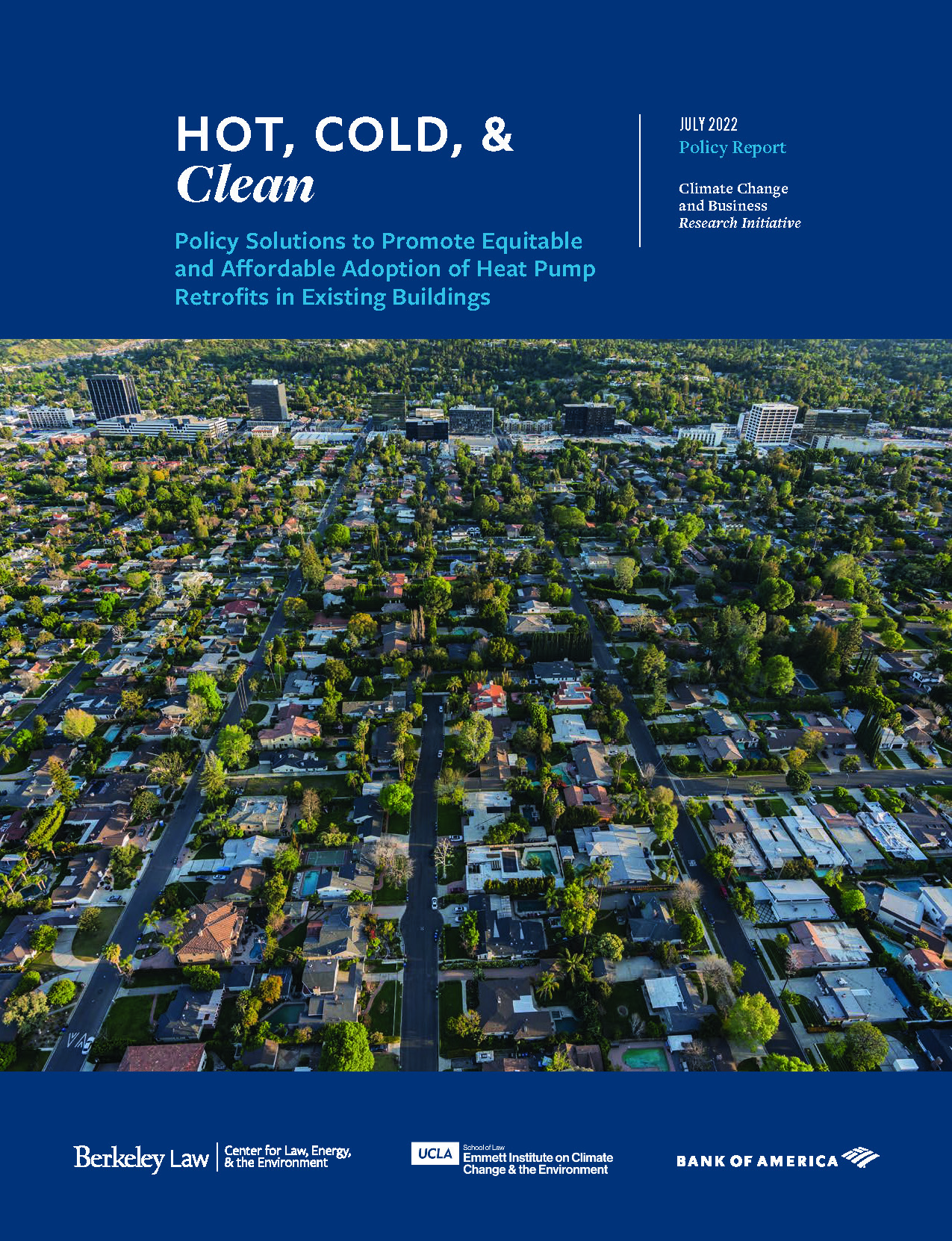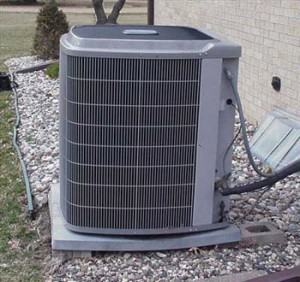
This post is co-authored by Ross Zelen.
As California and other leading climate jurisdictions move toward all-electric buildings, replacing older gas-powered furnaces and air conditioning units with heat pumps can reduce carbon emissions and indoor air pollution while increasing efficiency, comfort and resiliency, especially as extreme heat events increase. Heat pumps are a highly efficient technology that provides all-electric space and water heating and cooling, acting essentially as a two-way air conditioner.
Today, the Center for Law, Energy and the Environment (CLEE) at Berkeley Law and the Emmett Institute on Climate Change and the Environment at UCLA Law are releasing a new report, Hot, Cold, & Clean: Policy Solutions to Promote Equitable and Affordable Adoption of Heat Pump Retrofits in Existing Buildings, which highlights key policy solutions to ensure that California’s push to decarbonize existing homes and buildings will support equitable deployment of electric heat pumps.
Top-priority strategies include setting a clear phaseout timeline for natural gas space and water heaters, protecting low-income tenants from inadvertent rent increases or increased utility costs, and supporting “high road” job training programs to turn heating, ventilation and air conditioning (HVAC) installers and contractors into heat pump champions.
The stakes are high: California’s residential and commercial building sector accounts for nearly a quarter of the state’s greenhouse gas emissions and combustion of fuel for heating and cooling buildings generates more than 10 percent of state emissions. Electric heat pumps provide a deployable solution to reduce emissions from furnaces, water heaters, and other building appliances. To achieve state goals of 40 percent greenhouse gas emission reduction (below 1990 levels) by 2030 and carbon neutrality by 2045, California must significantly reduce emissions from the built environment.
Earlier this year, the California Energy Commission set out an ambitious target of deploying 6 million heat pumps by 2030. With more than 14 million existing residential homes in the state, more than 75 percent of California’s existing buildings built before 1978, and heat pumps installed in only 6 percent of new construction, the state has a long way to go to meet its goals.
Hot, Cold, & Clean is based on a convening of state, local, utility, housing and environmental leaders aiming to identify point-of-purchase, installation, and financing challenges that stymie heat pump deployment. The report captures the progress since our 2021 report Building toward Decarbonization and identifies additional policy solutions to overcome remaining barriers. For example, state leaders could:
- Set a clear timeline for the long-term phaseout of natural gas space and water heaters to provide certainty for utilities, homeowners, tenants and investors.
- Set zero-emission air quality standards for space and water heaters to make heat pumps the baseline technology.
- Enhance funding for low-income homeowners and affordable housing providers to improve electrical infrastructure to facilitate heat pump deployment, in a manner that prevents displacement and rent increases.
- Scale educational models and training programs for high road installer, maintenance, contractor and electrician positions and financially support deployment through midstream incentives for heat pump installations
This is not only a California issue. At the federal level, heat pumps have been recognized as a key technology to reduce reliance on fossil gas. On June 6, President Biden invoked the Defense Production Act (DPA) to rapidly expand domestic manufacturing of heat pumps to reduce building energy use and reduce U.S. reliance on oil and fossil gas. Current domestic U.S. HVAC manufacturing suppliers are not producing heat pumps at the rate needed. Additionally, the Department of Energy announced the first major update on gas-burning furnaces in 30 years, spurring more homes to move to heat pump solutions or adopt more efficient units. These actions should help address key barriers discussed in the report, such as the lack of heat pump supply and the need for increased manufacturer focus on educational workforce training.
To learn more, please join us next Tuesday, July 19 at 1:00 PM PT for a webinar to discuss the report and equitable heat pump deployment, featuring:
- Commissioner Andrew McAllister of the California Energy Commission
- Chelsea Kirk of Strategic Actions for a Just Economy (SAJE)
- Jose Torres of the Building Decarbonization Coalition.

Climate advocates are pushing for “building electrification” to get new and existing building off of natural gas altogether through appliance-switching, which would provide significant greenhouse gas savings and indoor air quality benefits (as I discussed last week). Now we have a new study documenting some significant cost savings (as well as emission reductions) that this switch could provide to homeowners who get off natural gas.
Energy and Environmental Economics, Inc. (E3) released the study quantifying the economic impacts of this transition for consumers of various appliances in existing and new residential buildings. Funded by utilities including Southern California Edison, Sacramento Municipal Utility District, and the Los Angeles Department of Water and Power, the researchers analyzed the cost impacts of electric air source heat pumps for space heating and cooling (HVAC), heat pump water heaters, electric and induction stoves, as well as electric and heat pump clothes dryers, compared individually to their natural gas alternatives.
The economic savings were notable. For new residential construction, all-electric appliances with today’s technology would result in lifecycle savings of $130 -$540 per year. It’s less clear though what the savings might be in general for retrofitting existing homes, as it depends on whether the building requires an electrical upgrade for all these new appliances and whether the homes have air conditioning.
The study also evaluated specific technologies in depth, including the key technology of electric heat pumps instead of using gas furnaces to heat homes. These heat pumps work by extracting heat from even cold winter air outside and pumping it indoors, and then pumping hot summer indoor air outside to cool a building.
E3 found the following cost-savings benefits with these heat pumps:
The installation of HVAC heat pumps can result in up to $550 per year in lifecycle savings relative to a combined gas furnace plus air conditioner(AC)system… However, homes without AC incur an extra lifecycle cost of $200 per year by switching to an HVAC heat pump. Heat pump water heaters (HPWHs) generate lifecycle savings of up to $150 per year over gas tankless water heaters in almost all home applications, but in retrofit homes, gas storage water heaters still appear to be the cheapest option… The net lifecycle costs of HPWHs are driven mainly by the capital cost.
Meanwhile, they found that electric hot water heaters generate savings of $150 per year over tankless natural gas heaters in new homes (not retrofits), as do electric cooktops. Electric clothes dryers though are currently more expensive than gas options.
In terms of emissions, the study found greenhouse gas reductions in single-family homes of 30%–60% over a natural-gas fueled home, given the projected electricity mix in 2020, and 80%–90% by 2050, assuming the projected carbon intensity of the grid by that year is realized.
Overall, the study is good news for those pushing for building electrification, as well as for any homeowner interested in making the switch to electric appliances to save money and reduce negative health impacts. With smart policy incentives to encourage adoption of these technologies in the home, from improved building standards to expanded financial incentives, California’s leaders could help homeowners achieve even further savings.
In the effort to reduce greenhouse gas emissions, glitzy technology like solar panels and electric vehicles get a lot of attention. But often times there are some simple and relatively cheap technologies that can make just as much difference, particularly when looking at the costs.
 Energy efficiency measures are a great example. Conserving energy is just as powerful, if not more so, than buying emissions-free energy like solar power. But it’s much cheaper. Case in point: updating your cable box to take advantage of new efficiency features can save you a lot on your utility bill.
Energy efficiency measures are a great example. Conserving energy is just as powerful, if not more so, than buying emissions-free energy like solar power. But it’s much cheaper. Case in point: updating your cable box to take advantage of new efficiency features can save you a lot on your utility bill.
Now David Roberts at Vox.com flags another promising technology: the heat pump.
A heat pump is a “mechanical-compression cycle refrigeration system” that can serve as both a furnace and an air conditioner (indeed, many air conditioners are just one-way heat pumps). From manufacturer Trane:
Even in air that seems too cold, heat energy is present. When it’s cold outside a heat pump extracts this outside heat and transfers it inside. When it’s warm outside, it reverses directions and acts like an air conditioner, removing heat from your home.
Because it merely moves, rather than generates, heat, it is far more efficient than combustion furnaces.
They key feature for our purposes is that heat pumps run on electricity. When Siemens modeled shifting 80 percent of citywide heat consumption over from natural gas to electric heat pumps, emissions declined another 14 percent…
Switching natural gas appliances to electric will be critical in the long term to reducing emissions from buildings. Right now, most furnaces and ranges are natural gas powered, but heap pumps can make the transition to electric heating much easier. Then when you combine it with emissions-free electricity such as from solar power, you’ve suddenly got a major climate win.
My guess is that with the right policy-based incentives (rebates and cheap financing), we could greatly spur consumer adoption of these technologies and ultimately bring the price down as economies of scale kick in. It would be a big win for the climate and potentially a cost-effective use of our resources.


